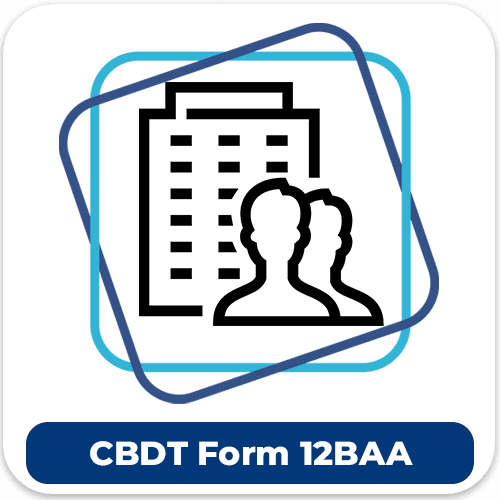The Central Board of Direct Taxes (CBDT) continues to shape India’s tax landscape, bringing more clarity to tax processes with the latest changes to the Income-tax (Eighth Amendment) Rules, 2024. In their Notification No. 112/2024, issued on October 15, 2024, significant modifications have been introduced to streamline tax deductions at source (TDS) and tax collection at source (TCS). These changes are set to have a substantial impact on both individual taxpayers and businesses, particularly regarding section 192(2B) of the Income-tax Act.
This article explores the essential details of these updates, breaking down the key changes, the new Form 12BAA, and revisions in reporting guidelines. Let’s dive in.

Key Highlights of CBDT‘s Latest Amendments
Revisions to TDS and TCS Provisions
One of the most significant changes revolves around the modifications to Rule 21AA. In the past, this rule referred to subsection 89(1), which dealt with relief for salary arrears. However, in this latest update, the rule now aligns with section 89 as a whole, bringing much-needed clarity in the computation of TDS and TCS. This adjustment will ensure a smoother calculation process for both taxpayers and tax professionals.
Why Is This Change Important?
This revision isn’t just a minor tweak; it simplifies the complex TDS/TCS system, particularly for taxpayers dealing with non-salary income. By eliminating the subsection, the rule becomes broader and more accommodating, which aligns the TDS framework with the most recent regulatory updates.
Introduction of Form 12BAA
Form 12BAA is the latest addition to the tax compliance toolkit. This new form is designed for reporting income derived from sources other than salary, as well as any losses incurred under house property. The introduction of this form simplifies the process of calculating TDS under section 192, which applies to salary payments.
H3: How Will Form 12BAA Impact Taxpayers?
Form 12BAA will allow taxpayers to present a more accurate reflection of their income, making it easier to calculate deductions and file returns. This could also lead to fewer discrepancies during tax assessments, ensuring smoother communication between taxpayers and tax authorities.
Enhancements to Existing Forms
CBDT has also made changes to various existing forms, including Forms 10E, 16, and 24Q. These forms now include additional columns specifically designed for reporting TDS and TCS under section 192(2B).
Why Update Existing Forms?
These enhancements are part of a broader effort to streamline tax documentation, making it easier to track non-salary income and TDS deductions. For businesses and individual taxpayers, this means more straightforward reporting and better transparency in financial documentation.
Detailed Reporting for Non-Salary Income: A Look at Rule 26B
In addition to the new forms, Rule 26B has been revised to guide taxpayers on how to report income outside of their salary. This is particularly important for individuals who earn additional income through other sources such as rental properties, dividends, or freelance work. The revision instructs taxpayers to use Form 12BAA for detailed reporting.
The Role of Rule 26B in Tax Compliance
Rule 26B now plays a pivotal role in ensuring that all types of income are accurately reported and accounted for. This update improves the overall transparency of the tax system and helps reduce errors in tax filings.
Why Are These Changes Significant?
A Move Towards Simplified Tax Compliance
These amendments show CBDT’s ongoing efforts to make tax compliance easier for both taxpayers and professionals. By introducing Form 12BAA and revising key forms and rules, the board aims to reduce errors, streamline the documentation process, and ensure a more accurate representation of individual and business income.
Impact on Businesses and Individuals
The modifications impact businesses that need to report non-salary income, as well as individuals who earn income from diverse sources. With better forms and updated rules, taxpayers can avoid potential errors, penalties, or delays during tax assessments.
Enhanced Accuracy in TDS Computation
For businesses, the changes mean a more accurate computation of TDS, especially in cases involving variable income streams. This is vital for organizations that manage a significant workforce or deal with contractors, as errors in TDS computation can lead to severe penalties.
Navigating the Changes
It’s essential that taxpayers, accountants, and tax professionals familiarize themselves with the new rules and forms to ensure full compliance. Missing these updates could lead to penalties, delays in tax filing, or even errors that could require amendments to previously filed returns.
Step-by-Step Guide to Using Form 12BAA
Understanding the Purpose of Form 12BAA
The primary goal of Form 12BAA is to provide a consolidated platform for taxpayers to report non-salary income. This form is particularly important for those who have income from house property or other income sources that don’t fall under the “salary” category.
Who Should Use Form 12BAA?
Form 12BAA should be used by taxpayers who have multiple income streams or who have suffered losses in house property. It offers a way to ensure that all types of income and relevant losses are recorded and reflected in the TDS computation.
Filling Out Form 12BAA: Key Sections to Focus On
While filling out Form 12BAA, taxpayers must focus on the sections detailing non-salary income and any associated losses. The form also includes provisions for reporting any deductions, ensuring that the final tax computation reflects the taxpayer‘s true financial position.
Avoiding Common Mistakes
Ensure that all income streams are reported accurately, and don’t forget to include deductions and exemptions where applicable. Mistakes in reporting could lead to discrepancies during tax assessment, which may result in penalties or additional tax liabilities.
Conclusion
CBDT’s latest revisions, including the introduction of Form 12BAA and updates to existing TDS and TCS guidelines, signify a broader move towards simplified and transparent tax processes. These changes not only enhance the accuracy of tax reporting but also empower taxpayers to better navigate their financial obligations. It’s crucial for both individuals and businesses to stay updated with these changes, ensuring compliance and minimizing potential risks in tax filings. Familiarizing yourself with the revised rules, updated forms, and new reporting requirements will set you on a path towards smoother tax assessments and fewer complications.
FAQs
- What is Form 12BAA?
Form 12BAA is a new tax reporting form introduced by the CBDT, aimed at helping taxpayers report income from non-salary sources and house property losses. - Who needs to use Form 12BAA?
Taxpayers with income from house property or any non-salary income streams need to use Form 12BAA for accurate tax computation. - Why did CBDT update the TDS and TCS rules?
The revisions aim to simplify the tax reporting process and provide clarity for taxpayers, especially in reporting non-salary income. - What changes were made to Forms 10E, 16, and 24Q?
These forms now include additional columns for reporting TDS and TCS under section 192(2B), improving overall tax documentation. - How can businesses benefit from these changes?
The updates help businesses by ensuring more accurate TDS computation, particularly for employees and contractors with variable income streams.

